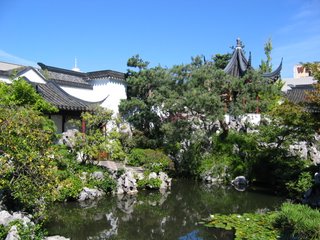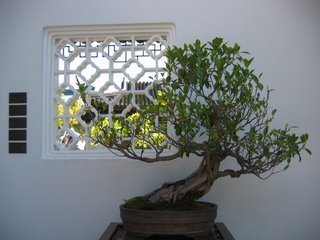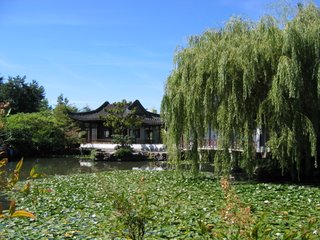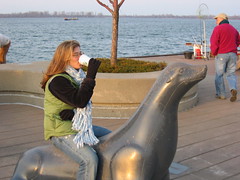 it's set on a pile of rocks emulating a mountain, and is meant to represent humans in their natural setting. There was also a lovely waterfall in the rocks. This is the focal point of the garden, and you can also see it buried in the trees in this photo, which was taken from the other side of the garden.
it's set on a pile of rocks emulating a mountain, and is meant to represent humans in their natural setting. There was also a lovely waterfall in the rocks. This is the focal point of the garden, and you can also see it buried in the trees in this photo, which was taken from the other side of the garden. This photo also shows the water, which is a key part of Chinese gardens. The water is made intentially cloudy, using a special clay lining, to intensify the reflections. You can see the water flowing under the Jade Water Pavillion here:
This photo also shows the water, which is a key part of Chinese gardens. The water is made intentially cloudy, using a special clay lining, to intensify the reflections. You can see the water flowing under the Jade Water Pavillion here:
This photo also shows the intricate wooden screens on this building, which were put together without using any screws or nails, and if you know which piece to remove you can take the whole thing apart quite easily. Here is another view of that building:

There were many cool rocks, called Tai Hu rocks. These are naturally carved limestone rocks from Lake Tai in China. They're really neat, all pitted and holey, so that you can see things in them if you use your imagination.

The floor in all the outdoor spaces was intricately tiled, and each floor was different. The stones are individually selected for size and shape. The white bits are old pieces of pottery, and the curved grey pieces are old roof tiles. This is a good example, from the area near the first photo. Walking barefoot on these floors was like a slightly painful foot massage!
Lastly, here is an example of a penjing, which is a forefather of Japanese bonsai. It's different from bonsai in that the trees are selected for their interesting growth patterns and then pruned, instead of being forced into doing something interesting.
The garden was really beautiful - if you're ever in Vancouver you really must check it out, although I would give the rest of Chinatown a miss. I've been to several large Chinatowns (New York, San Francisco, Chicago (not so large)), and although Vancouver's is supposed to be the largest, it's very different from the others. It seems less touristy, which is good, but also means that you don't find the neat souvenirs and things that people associate with Chinatown. Plus it's bordered by a pretty sketchy area, and overall we weren't impressed. But we had good food, I got some cool stationary (I'm on a stationary kick these days), and my mom found a beautiful beaded shawl for only $15, which was an absolute bargain, so overall it was a success. And the garden, as I said, was exquisite and well worth the visit!


1 comment:
just spectacular. it makes me think I should actually run away for a few days- I think I could happily live in that garden for a few days as long as there was knitting handy.
Post a Comment